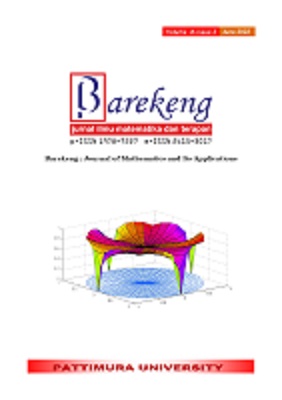COMPARISON OF FORECASTING VIOLENCE CASES NUMBER AGAINST WOMEN AND CHILDREN USING DOUBLE EXPONENTIAL SMOOTHING (DES) AND AUTO REGRESSIVE INTEGRATED MOVING AVERAGE (ARIMA) METHODS
Abstract
Violence is something that is being widely discussed. It is due to the increasing number of victims of violence in a scope where victims should feel safe. Therefore, the researchers took this case intending to predict the number of violence cases against women and children in Jakarta so that the government can anticipate the spike in cases and evaluate the policies that will be issued in this case. The data used was from the Office for the Empowerment of Child Protection and Population Control (DPPAPP) of DKI Jakarta Province from January 2018 to October 2021 to predict the number of cases in 2022. Based on the analysis results, it is known that the number of cases of violence against women and children has decreased throughout 2022. In addition, the accuracy of the model using the Double Exponential Smoothing (DES) method is 44.91%, and the Auto-Regressive Integrated Moving Average (ARIMA) is 39.03%.
Downloads
References
M. G. Sopacua, “Konsep Ideal Pencegahan Kekerasan Dalam Rumah Tangga Terhadap Perempuan,” vol. 4, 2022.
A. Kamal, P. Anggraini, and Renita Astri, “Web Untuk Pengaduan Bagi Korban Kekerasan Terhadap Perempuan dan Anak,” J. Sains dan Inform., vol. 4, no. 1, pp. 63–69, 2018.
M. Indriyani, Pemodelan regresi spline menggunakan metode penalized spline pada data jumlah kasus kekerasan terhadap anak di indonesia. 2020.
A. H. Al Farikhi and M. Y. Darsyah, “Perbandingan Autoregressive Integrated Moving Average ( Arima ) dan Double Exponential Smoothing pada Peramalan Curah Hujan di Provinsi Aceh,” Statistika, vol. 4, no. 1, pp. 471–478, 2018.
A. K. Rachmawati, “Peramalan Penyebaran Jumlah Kasus Covid19 Provinsi Jawa Tengah dengan Metode ARIMA,” Zeta - Math J., vol. 6, no. 1, pp. 11–16, 2020, doi: 10.31102/zeta.2021.6.1.11-16.
S. Kinasih, A. Agoestanto, and Sugiman, “Optimasi Parameter pada Model Exponential Smoothing Menggunakan Metode Golden Section untuk Pemilihan Model Terbaik dan Peramalan Jumlah Wisatawan Provinsi Jawa Tengah,” Unnes J. Math., vol. 7, no. 1, pp. 38–46, 2018.
E. S. Sembiring and Z. Syahputra, “Prediksi Aktivitas Tanpa Masker Dengan Kombinasi Metode Single Exponential Smoothing Dan Fuzzy Time Series,” vol. 2, no. 1, pp. 57–62, 2022.
M. H. I. Priambudi, E. L. Amalia, and A. N. Pramudhita, “Sistem Informasi Peramalan Jumlah Pengunjung Menggunakan Metode Double Exponential Smoothing (Studi Kasus Body Gym Kota Malang),” J. Inform. Polinema, vol. 7, no. 1, pp. 23–28, 2020, doi: 10.33795/jip.v7i1.431.
C. Chandra and S. Budi, “Analisis Komparatif ARIMA dan Prophet dengan Studi Kasus Dataset Pendaftaran Mahasiswa Baru,” J. Tek. Inform. dan Sist. Inf., vol. 6, no. 2, pp. 278–287, 2020, doi: 10.28932/jutisi.v6i2.2676.
F. Fejriani, M. Hendrawansyah, L. Muharni, S. F. Handayani, and Syaharuddin, “Forecasting Peningkatan Jumlah Penduduk Berdasarkan Jenis Kelamin menggunakan Metode Arima,” J. Kajian, Penelit. dan Pengemb. Pendidik., vol. 8, no. 1 April, pp. 27–36, 2020, [Online]. Available: http://journal.ummat.ac.id/index.php/geography/article/view/2261/pdf.
H. D. Saribu, “Pengaruh Brand Equity Terhadap Purchase Intention,” J. Mantik Penusa, vol. 3, no. 1, pp. 21–26, 2019, [Online]. Available: http://e-jurnal.pelitanusantara.ac.id/index.php/mantik/article/view/574.
I. Nabillah and I. Ranggadara, “Mean Absolute Percentage Error untuk Evaluasi Hasil Prediksi Komoditas Laut,” JOINS (Journal Inf. Syst., vol. 5, no. 2, pp. 250–255, 2020, doi: 10.33633/joins.v5i2.3900.
Z. Arifin, J. Herliani, and Hamdani, “Peramalan Pengangguran Menggunakan Metode Double Exponential Smoothing Di Provinsi Kalimantan Timur,” Pros. Semin. Nas. Ilmu Komput. dan Teknol. Inf., vol. 4, no. 1, pp. 24–29, 2019.
L. Farosanti and H. Mubarok, “Analisa Peramalan Penjualan Alat Kesehatan dan Laboratorium di PT . Tristania Global Indonesia Menggunakan Metode ARIMA,” J. Inform. Merdeka Pasuruan, vol. 7, no. 1, pp. 14–18, 2022, doi: http://dx.doi.org/10.37438/jimp.v7i1.428.
Y. I. AJUNU, N. ACHMAD, and M. R. F. PAYU, “Perbandingan Metode Autoregressive Integrated Moving Average Dan Metode Double Exponential Smoothing Dari Holt Dalam Meramalkan Nilai Impor Di Indonesia,” Jambura J. Probab. Stat., vol. 1, no. 1, pp. 37–46, 2020, doi: 10.34312/jjps.v1i1.5393.
Authors who publish with this Journal agree to the following terms:
- Author retain copyright and grant the journal right of first publication with the work simultaneously licensed under a creative commons attribution license that allow others to share the work within an acknowledgement of the work’s authorship and initial publication of this journal.
- Authors are able to enter into separate, additional contractual arrangement for the non-exclusive distribution of the journal’s published version of the work (e.g. acknowledgement of its initial publication in this journal).
- Authors are permitted and encouraged to post their work online (e.g. in institutional repositories or on their websites) prior to and during the submission process, as it can lead to productive exchanges, as well as earlier and greater citation of published works.






1.gif)



